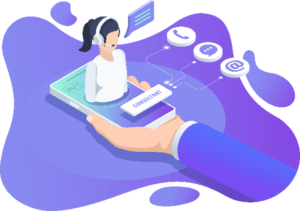Dead air time refers to the period of inactivity during customer interaction in a contact center; the time between when an agent finishes speaking and when the customer begins speaking or vice versa. Dead airtime can negatively impact the customer experience and make the interaction feel awkward or uncomfortable.
In a contact center setting, it is essential to minimize dead air time as much as possible to ensure a smooth and seamless customer experience. This can be achieved through coaching agents and implementing technology solutions that can automatically fill dead air time with pre-recorded messages or music. Thus. reducing disquiet time can help to enhance the overall customer experience and improve customer satisfaction.
Key points:
- How dead airtime negatively impacts the customer experience
- The role of planning and preparation in reducing dead airtime
- The advantages of having an organized workflow in reducing dead airtime
- Technologies, training, and continuous development in resolving dead airtime issues
Effective Planning and Preparation to Reduce Dead Airtime
Here are some steps you can follow to plan and prepare to reduce dead airtime effectively:
1. Measure current dead airtime:
To reduce dead air time effectively, you first need to know how much disquiet time is occurring in your current interactions.Through call recording and analysis tools. Then, to proactively measure disquiet time, you can :
- Use call recording and analysis tools to capture and then analyze interactions between agents and customers.
- Identify instances of dead airtime during the interactions.
- Record the duration of dead airtime in each interaction.
- Average the dead air time across a representative sample of interactions.
2. Set a goal for dead airtime reduction:
Set a realistic and achievable goal for reducing dead air time based on your current measurements. You might aim to reduce quiet air time by 50% in the next quarter.
Set up a goal to reduce dead air time:
- Based on the average dead air time obtained in step 1, determine a realistic and achievable goal for reducing quiet air time.
- Set a timeline for achieving this goal.
- Consider the resources and budget required to achieve the goal.

3. Train agents:
Provide your agents with practical training on how to minimize dead airtime. This also includes techniques for keeping the conversation flowing, such as active listening and effective questioning.
To effectively train agents, you should :
- Develop and provide training programs focusing on effective communication and active listening.
- Teach agents techniques for keeping the conversation flowing and reducing dead airtime.
- Provide regular coaching and feedback to help agents improve their skills.
4. Implement technology solutions:
Technology solutions can automatically fill dead air time with pre-recorded messages or music. Consider implementing such a solution to help reduce quiet air time and improve the overall customer experience.
To successfully implement technology solutions, you can :
- Research and evaluate technology solutions that can automatically fill dead air time with pre-recorded messages or music.
- Choose the solution that best fits your needs and budget.
- Implement the solution and train agents on how to use it.
-
Invest in the right technology to reduce dead air time, such as our own OMNI+ solution. With its remarkable features and easy-to-use interface, OMNI+ will help your agents drastically cut dead air time off, and provide seamless customer interactions.
5. Monitor and evaluate progress:
Regularly monitor and evaluate your progress toward reducing dead air time. Use this information to make any necessary adjustments to your approach and ensure that you are on track to meet your goal.
To adequately monitor and evaluate, you need to:
- First, regularly monitor and progress toward reducing dead air time.
- Use call recording and analysis tools to obtain data on disquiet time.
- Compare this data to your goal to determine if you are on track to achieve it.
- Finally, make the necessary adjustments to your approach to ensure that you are on the tramway and meet your goal.
Following these steps and a concerted effort to reduce dead air time, you can improve the customer experience, enhance customer satisfaction, and ultimately drive business success.

The importance of scripting and scripting tools
Scripting, with its tools, is essential in reducing dead airtime in contact centers because it structures how agents handle customer interactions.
Scripts provide agents with the information they need to efficiently handle common customer inquiries. Thus reducing the time spent searching for information or thinking about how to respond.
Scripting tools provide real-time guidance to agents, ensuring they stay on track and remain compliant with company procedures. By streamlining interactions and reducing the time spent handling each call, scripting helps contact centers reduce dead air time and improve the overall efficiency of their operations.
Some examples of script tools that can help reduce dead air time in contact centers include:
- Interactive Voice Response (IVR) systems: IVRs allow customers to self-serve and resolve issues without needing agent intervention, reducing the time spent on each call.
- Chatbots: Chatbots can handle simple inquiries and provide customers with the information they need, freeing up agents to address complex issues.
- Call scripting software: They provide agents with a step-by-step guide to handling customer inquiries. Thus reducing the time spent searching for information or formulating a response. The software can also provide real-time guidance to agents, ensuring they stay on track and remain compliant with company policies and procedures.
- Knowledge Management Systems: These systems store and organize information and can provide agents with quick access to the information they need to handle customer inquiries, reducing the time spent searching for information.
These tools can help reduce dead air time in contact centers, improve the customer experience, and increase overall efficiency by providing agents with the information and guidance they need to handle customer inquiries efficiently.
The advantages of having an organized call flow
- Increased efficiency:
Each interaction follows a structured process, reducing the time spent searching for information or thinking about how to respond. Also, If a customer calls about a product issue, the call flow will provide the agent with the necessary steps to troubleshoot the problem, including any relevant information or questions to ask the customer.
- Improved customer experience:
Each customer interaction is handled consistently and professionally. This improves customer satisfaction, as customers are more likely to have a positive experience when they receive prompt, accurate, and consistent service.
- Optimized training and onboarding:
A clear and consistent training process for new agents reduces the time it takes to onboard and train new hires. In addition, agents can follow the call flow as they handle customer inquiries, providing consistent and accurate information.
- Increased compliance:
An organized call flow helps agents follow company policies and procedures, reducing the risk of compliance issues. If a company has specific policies regarding handling sensitive customer information, it will provide clear guidance to agents on taking such information in a compliant manner.
With NobelBiz’s OMNI+, you don’t have to worry if your business is at risk of breaching compliance. With our top-notch personnel keeping an eye on every compliance and procedure change, we keep our promise to provide outstanding interactions to enhance the customer experience.
- Enhanced data collection:
A consistent process for collecting customer information and data makes tracking and analyzing customer interactions easier. This information is used to identify areas for improvement and monitor the call center’s overall performance. Data on call wait times, transfer rates, and customer satisfaction can be used to identify areas contributing to dead air time and make changes to improve efficiency and the customer experience.
In the next chapter, we develop more on the appropriate technologies used to reduce dead airtime.
Invest in the Right Technology to Reduce Dead Airtime
Investing in the right technology can help reduce dead air time in contact centers and improve overall efficiency. Here are some steps that can help ensure you invest in the right technology:
- Assess your needs:
Start by evaluating your current operations and identifying the areas where dead air time is most prevalent. This can help you determine what technology you need to address these issues and improve efficiency. - Research available technologies:
Once you clearly understand your needs, research the various technologies available that can help reduce dead air time. This may include IVR systems, chatbots, call scripting software, and knowledge management systems. - Evaluate potential solutions:
When researching technologies, consider fast, easy use, integration with existing systems, and the level of support offered. Be sure to consider the technology’s scalability and whether it can grow with your contact center as your needs change. - Test and pilot potential solutions:
Before investing in a solution, testing and piloting potential solutions is essential to ensure that they meet your needs and provide the desired results. This will also allow you to understand better the technology and how it can benefit your contact center. - Choose the right technology:
Based on the results of your tests and pilots, choose the technology that best meets your needs and provides the best results. Consider the total cost of ownership, including hardware, software, and support, to ensure that you make an intelligent investment. - Implement and integrate:
Once you have chosen the technology, implement and integrate it into your contact center operations. Be sure to provide adequate training to your agents to use the technology to reduce dead air effectively.
By following these steps, you can ensure that you make a wise investment that provides the desired results and improves overall efficiency.
Benefits of using call center software with call monitoring and call recording features
- Improved agent performance:
Software with these features allows supervisors and managers to listen in on customer interactions and provide feedback to agents. This can help identify areas for improvement and provide targeted training, leading to improved agent performance and reduced dead air time.
- Quality assurance:
Call monitoring and recording provide a way to evaluate the quality of customer interactions, ensuring that agents are following company policies and procedures and providing consistent information. This helps improve the overall customer experience and reduce the risk of compliance issues.
- Training and development:
Call recordings can be used as training tools for new agents and ongoing professional development. Listening to successful interactions can help agents learn best practices, and reviewing complex interactions can help identify areas for improvement.
- Conflict resolution:
Call recordings can also be used to resolve customer complaints and disputes. A record of the interaction can help clarify what was said and provide a more accurate representation of the events.
- Data analysis:
Call recordings provide a wealth of data that can be analyzed to identify trends and areas for improvement. Data on call wait times and transfer rates can be used to identify recall flow areas contributing to dead air time and to make changes to improve efficiency.
- Compliance:
Call recording features can help ensure that agents follow company policies and procedures, reducing the risk of compliance issues. For example, if a company has specific guidelines for handling sensitive customer information, call recordings can help ensure that these policies are followed.
Moreover, contact center software with call monitoring and recording features can help reduce dead air time by improving agent performance, ensuring quality, providing training opportunities, resolving conflicts, analyzing data, and ensuring compliance.
The Importance of real-time call analytics for identifying dead airtime issues
Real-time call analytics are critical for identifying dead airtime issues in contact centers. Here are some of the key benefits of real-time call analytics:
- Identification of trends:
Real-time call analytics can help identify trends in dead air time, such as which agents are most affected, which times of day are most problematic, and which types of calls are most likely to result in dead air time.
- Quick response:
By identifying dead air time issues in real-time, contact centers can respond quickly and take action to resolve the issue, reducing the impact on the customer experience.
- Continuous improvement:
Real-time call analytics can help to monitor and improve contact center operations continuously. By analyzing data in rehearsal time, they can identify areas for improvement and make changes to reduce dead airtime and enhance the customer experience.
- Improved customer satisfaction:
Contact centers improve the overall customer experience by reducing dead air time, leading to increased customer satisfaction and loyalty.
- Increased efficiency:
Real-time call analytics can help optimize contact centers operations and reduce waste, leading to increased efficiency and improved use of resources.
Real-time call analytics is critical for reducing dead airtime in contact centers. Contact centers can quickly identify and resolve slow air time issues. Providing real-time insights into call center operations leads to improved customer satisfaction, increased efficiency, and continuous improvement.
We further discuss how training and agent development contribute to reducing dead airtime.
Regular Training and Development to Address Dead Airtime Issues
Regular training and development are crucial in addressing dead airtime issues in contact centers. By providing ongoing training and professional development opportunities. Contact centers can effectively equip agents with the skills and knowledge to handle customer interactions and reduce dead air time. This includes training on effective communication, call operating techniques, and tools to streamline call flows and improve efficiency. By investing in the training and development of agents, contact centers can improve overall agent performance, increase customer satisfaction, and reduce dead air time., leading to a more efficient and effective call center operation.
The importance of ongoing training for agents to address dead airtime
Ongoing training for agents is crucial in addressing dead air time in contact centers. Practicing regularly gives agents the skills and knowledge they need to effectively handle customer interactions, reducing the risk of quiet air time and improving overall efficiency. Ongoing training also helps agents quickly adapt to changes in procedures, technology, and customer needs, reducing the impact of these changes on the customer experience. By investing in the training and development of agents, contact centers can improve overall agent performance, increase customer satisfaction, and support agents’ professional development.

The benefits of using performance management and coaching tools for agent development
Using performance management and coaching tools can benefit agent development in contact centers. Here are some key benefits:
- Improved performance:
The tools provide real-time feedback and insights into agents’ performance, enabling contact centers to identify areas for improvement and provide targeted coaching and training. - Increased efficiency:
Contact centers can quickly identify and resolve performance issues by using these tools. Thus improving overall agent efficiency and reducing the risk of dead air time. - Increased motivation:
Performance management and coaching tools can help agents set and achieve performance goals, leading to increased motivation and job satisfaction. - Continuous improvement:
By continuously monitoring and improving agent performance, contact centers can support the ongoing development of agents and drive continuous improvement in the contact center. - Improved communication skills:
Regular training can help agents develop practical communication skills and improve their ability to handle customer interactions, thus reducing the risk of dead air time. - Increased efficiency:
Contact centers can help agents streamline call flows and improve overall efficiency by providing training on technology and tools, reducing dead air time. - Improved customer satisfaction:
Regular training can help agents provide a better customer experience, reducing the risk of customer frustration and increasing customer satisfaction. - Adaptation to changes:
Ongoing training can help agents quickly adapt to changes in procedures, technology, and customer needs. Thus reducing the impact of these changes on the customer experience. - Professional development:
Regular training provides opportunities for professional development and career advancement for agents to retain top talent and improve overall agent performance.
Conclusion
In conclusion, reducing dead air time is crucial for improving efficiency.
Various tools and practices can help address dead air time, including scripting tools, an organized call flow, call center software with call monitoring and recording features, and the remaining ones we cited in the article. By investing in the right technology, regularly training and developing agents, and continuously monitoring and improving performance, contact centers can reduce dead air time and achieve a more efficient and effective contact center.
Additionally, by following these best practices and using insights integrated into our OMNI+ solution, you can optimize strategies, improve efficiency and ensure that agents have every tool in place to abate dear air time.
That’s not all. Our all-in-one contact center software offers advanced features such as omnichannel support, intelligent call routing, and real-time analytics, all backed by 24/7 customer support.
Boost your team’s productivity and improve customer satisfaction and retention with NobelBiz OMNI+.

Andrei is an experienced marketing professional specializing in propelling growth for both B2B and B2C companies. Proficient in streamlining marketing operations and enhancing lead and customer experiences through SEO and marketing techniques.







